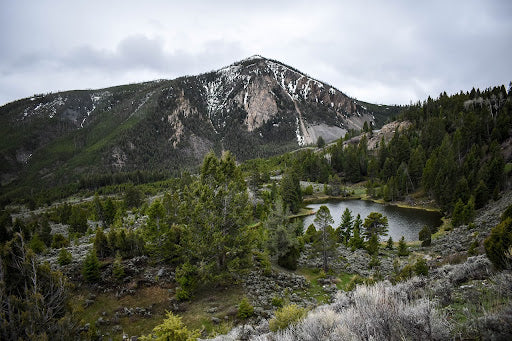As the first national park ever established, in 1872, it’s no wonder why so many country and nature lovers make their way to Yellowstone National Park every year. With over 500 geysers, eye-catching wildlife, such as bison and elk, and the place where the popular show Yellowstone is filmed, there is a lot to experience while in this must-visit national park. It is the place where geothermal landscapes thrive—fumaroles, geysers, and hot springs can be found all over the park.
Yellowstone is a great national park for families and solo travelers alike. If you’re heading out west on your national park road trip, then here is everything you need to know about visiting Yellowstone National Park in your RV.
Know Before You Go
Yellowstone National Park requires an entrance pass to get into the park. The park is open year round and park roads are typically open from April to November, but may be closed during other times of the year due to unexpected weather. The most popular time of year to visit Yellowstone is June through August, but spring and fall are great times of year to visit this park since you can avoid the large crowds and experience more mild weather.
Things to Do
While at Yellowstone National Park, you can do everything from catching a glimpse of an erupting geyser to driving by a variety of wildlife. Here are the best things to do while in the park.
Drive By Bison

Did you know that bison, the chocolate brown mammal with a large hump on its back, is the largest land-dwelling mammal in all of North America? Yellowstone National Park is the only place they’ve continued to live since prehistoric times. The park preserves the most significant herds in the country. While exploring areas like Hayden Valley, located in the middle of the park, you can observe bison roaming freely in their natural habitat. The valley is easy to get to and it is best to go during the day or dusk since that is when bison are the most active. Observing this majestic mammal up close is an experience you won’t want to miss while in Yellowstone.
Spend a Day on Yellowstone Lake

With hydrothermal features hiding beneath its waters and its extensive size, there is no body of water like Yellowstone Lake. At 20 miles long and 14 miles wide, Yellowstone Lake is the largest high elevation lake above 7,000 feet in North America. What’s more, this lake is home to the greatest population of wild cutthroat trout in all of North America, a Pacific Ocean fish. To explore Yellowstone Lake, you can do a hike, such as the 0.8-mile Pelican Creek Nature Trail, drive along the north side of the lake in your RV, or explore by boat or kayak on a guided tour.
Hike by Hot Springs

Hot springs are the most common hydrothermal feature in all of Yellowstone National Park. There are more than 10,000 hydrothermal features in the park, including hot springs, such as Emerald Pool, which is one of the many colorful hot springs, Crested Pool, which sometimes acts like a geyser due to its eruptions, and Mammoth Hot Springs, which looks like a frozen waterfall. Hot springs can get their unique color from thermophiles, which are microorganisms that thrive in hot temperatures!
Watch Erupting Geysers

Just like hot springs, geysers are a hydrothermal feature that add to the unique geological landscape in Yellowstone. The park is home to more than 500 geysers, such as the world’s tallest one that is still active, Steamboat Geyser, which erupts more than 300 feet in the air! You may have also heard of Old Faithful Geyser, a popular attraction in the southeast area of the park, which is a geyser that erupts more than 20 times per day. The eruptions are unpredictable, which make them exciting to see.
Where to Stay
With 12 RV-friendly campgrounds in the park, campers will have plenty of spots to choose from. All campsites must be reserved in advance besides Mammoth Campgrounds, which operates on a first-come, first-serve basis. Camping is only allowed at designated campgrounds in the park.
- Bridge Bay Campground — located near Yellowstone Lake; no hookups available
- Canyon Campground — located in Canyon Village with plenty of stores and food spots in the area; no hookups available
- Fishing Bridge RV Park — located near Yellowstone River; hookups available
- Grant Village Campgrounds — located south of Yellowstone lake with food and store nearby; no hookups available
- Madison Campground — located north of Old Faithful; no hookups available
- Indian Creek Campground —located slightly south of Mammoth Hot Springs; no hookups available
- Mammoth Campground — located just south of the North Entrance; no hookups available
- Norris Campground — located near the Museum of the National Park Ranger; no hookups available and the park is closed in 2024
- Pebble Creek Campground — located near the Northeast Entrance; no hookups available
- Tower Fall Campground — located near the Tower General Store; no hookups available and the park is closed in 2024
- Lewis Lake Campground — located near the South Entrance; no hookups available
- Slough Creek Campground — located off a small dirt road and is ideal for small RVs; no hookups available

With its unique geothermal features and large wildlife, Yellowstone National Park should be a bucket list destination for everyone. There’s nothing like driving by a herd of bison and erupting geysers as you make your way to your campsite in your RV. If you’re looking for other national parks on the west coast to explore this summer, then we suggest adding Crater Lake National Park to your road trip itinerary.
See you on the road!



Share:
The 5 Best Places to Fly Fish in the U.S.
RV-Friendly Wineries and Breweries